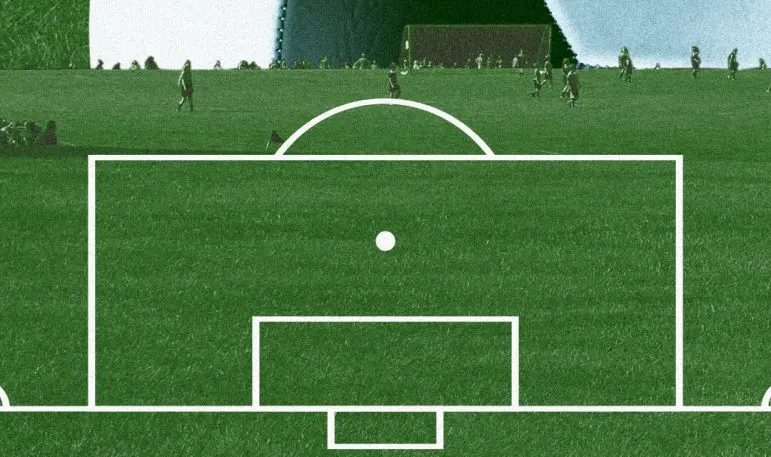Last October, almost a year to this day, the United States men’s national soccer team, then ranked 28th, was outplayed and ultimately defeated by a Trinidad and Tobago outfit ranked 99th in the world. The 2-1 loss, coupled with final results from two other qualifying games, eliminated the USMNT from World Cup contention for the first time since 1986.
In the wake of the embarrassment, the entire U.S. soccer system has been given a thorough autopsy by analysts, journalists, fans, and even national team players themselves. The USMNT’s failure to qualify has been attributed to a host of issues, from naive tactics to poor player development that led to a lost generation of young sporting talent.
Over the past decade in the United States, overall youth participation in sports has declined–soccer has been the sport hardest hit. The fact is, fewer kids play soccer in America since its peak a decade ago, even when you include casual fans and kids who touch a soccer ball once a year. And the people who still do play are self-selecting, indicating another, more deeply rooted issue: Well-off kids have a much easier time making it in the soccer world.

“We want to use football and the engagement of the community to create hope for change through formal or informal education or though healthy activities–anything that can bring self-belief and confidence and social skills to an individual that gives them an opportunity to change,” Jon Burns BEM, president and CEO of Lionsraw, tells Fast Company. “That’s why we all exist, that’s what we do.”
After the 2010 World Cup in South Africa, Lionsraw volunteers broke ground with four building projects in the Valley of a Thousand Hills outside Durban, including a local football pitch with changing rooms, a four-bedroom house for a children’s home, and a two-classroom primary school complete with a block of flush toilets. In Brazil, after the 2014 tournament, nearly 300 volunteers teamed up to build an education and after-school complex offering music classes, soccer training, and academic tutoring to underserved children outside host city Curitiba.
The organization hopes to fix the fact that many young players, especially those from low-income communities, are being priced out of the sport. According to a Sports & Fitness Industry Association (SFIA) study published this year, the majority of outdoor soccer participants have a household income of over $75,000, with the highest participation rates coming from families earning more than $100,000 a year. Perhaps that’s no surprise: It’s not uncommon for a single family to spend more than $10,000 enrolling their child in organized youth soccer, when you combine league and team fees, equipment, apparel, travel, and more.
“American soccer executives simply don’t care about Hispanic talent, which is worse than being incompetent,” SB Nation soccer editor Kim McCauley wrote in January. That’s a sentiment echoed by Brad Rothenberg, cofounder of Alianza de Futbol, an organization that runs free-to-play soccer camps and other events aimed at Hispanic youth.
But it’s not just Hispanic players who are getting left behind or forgotten (Jonathan González, anyone?), either.
“While soccer has boomed in the U.S., becoming a staple of suburban life, it has barely made a ripple in African-American communities,” Washington Post reporter Les Carpenter writes in the Guardian. “One of the world’s most democratic games, played on streets and in alleys around the globe, would seem a natural fit for America’s predominately black inner cities, where basketball thrives on playground courts. Instead, it’s almost nonexistent.”
Indeed, according to SFIA, only about 7.5% of youth outdoor soccer players are black–a lower rate than those seen in basketball (nearly 25%), tackle football (almost 14%), or baseball (just under 10%).

The details for the rollout are still scant, but 26×26 program director Ben Astin says that all 26 sites are being decided by 2022, with programming attached to help boost soccer’s popularity. The initiative’s current plans, Astin says, project 20 fields in the U.S. and three each in Canada and Mexico.
“We want to bring programming that’s sustainable over at least 10 years,” Astin says. “We want to bring the right organizations to these communities, or at least engage with an already established local leader that’s going to use the field in the right ways. That’s what will contribute to not only the popularity of the sport, but also the development of the soccer talent that’s out there.”
Key in the development of 26×26’s programming is the expertise of LISC, which, over the past 20 years and with $50 million in investment from the National Football League, has built and rehabbed close to 350 fields in underserved communities across the country. For example, this year in Milwaukee, Wisconsin, one of the most segregated cities in the United States, LISC partnered with the NFL Foundation and the Green Bay Packers to install a new multipurpose field at Casimir Pulaski High School, a public school with 93% minority enrollment (the artificial turf field is used by the school’s soccer team, too).
After about 20 minutes of discussion with Lionsraw, LISC CEO Maurice A. Jones jumped at the chance to get involved with 26×26.
“One of the great challenges of high schools, particularly in urban areas, is that they don’t have quality fields to practice and play on,” Jones tells Fast Company in a phone interview. “The pride that [the Pulaski Rams] have now, and the ability to play home games, which a lot of us take for granted–it’s hard to place a monetary value on that, but it’s huge.”
The costs aren’t always hidden. Today, access to field space comes at a premium, even in progressive cities like Seattle. The metro area is a hotbed for soccer in America, but fields are quickly “snatched up by wealthy, mostly white clubs who [have] the money and expertise to navigate the city’s leasing process,” writes Les Carpenter, in another story for the Guardian.
Without local field access, families, disproportionately those from communities of color, are forced to spend hours driving to the closest quality training center (a fact curiously applauded by American commentators during a recent U.S.-Mexico friendly). “The result,” according to Villanova sociology professor Rick Eckstein,” is a system more attuned to identifying the best payers than the best players.” Those who can’t pay dropout: Around 4 in 10 youth soccer players leave the sport after the age of 13, and there are now reports out of California that top U.S. prospects are heading to Mexico in search of opportunity.
None of this is breaking news, really, and the issue of diversity has been brought up time and time again for the better part of the last decade And for years, an indictment of the U.S. soccer development system was the number of USMNT players raised in the youth systems of other countries–a divide which caused some tension on the team. So what has changed now, one year after U.S. Soccer’s darkest hour and a half? Whether you’re talking about curbing declining youth participation rates or tactical changes on the professional pitch, the answer is: not a lot. Carlos Cordeiro was elected U.S. Soccer Federation president in February, but the team still hasn’t named a new manager–and fluency in English is the only coaching qualification the federation has advertised publicly. That didn’t stop U.S. Soccer from declaring, in a 198-word aspirational-sounding but mostly empty statement, that the “future is here.” (There’s a new hashtag, too.)
To really make the U.S. into an international soccer powerhouse will require fixing the development system, which Justin Brunken, VP of the American Outlaws, the premier 25,000-member-strong U.S. Soccer supporters group, describes as a mess. 26×26 offers hope that some of America’s best young athletes will have access to a soccer field as the place to realize their potential.
“As fans, we can help people love the game more, which I think is healthy,” he says. “Giving people the ability to play, and helping more and more young kids be passionate about it through local community efforts, will only have positive effects on how many kids are potentially going to be professional soccer players on the national team.”

It’s not just fans (including many American Outlaws) who are getting involved, either: 26×26 has already locked in participation from UNICEF USA and attracted high-profile ambassadors in American soccer stars Landon Donovan and Kyle Martino (who ran unsuccessfully for U.S. Soccer president) as well as soccer broadcasters Kay Murray and Rob Stone.
Of course, 26 fields won’t change the system. But that’s why the 26×26 initiative will rely on a request for proposal process (basically a competition to select the best ideas and sites). Jones says that at every field site, 26×26 will make sure that a local partner, like the Green Bay Packers in Milwaukee, puts financial resources on the table. That’s been the winning formula on the NFL side, Jones says, in elevating fields from basic green space to true assets for under-resourced communities.
It’s worth noting that Major League Soccer has 20 teams in the United States and three more in Vancouver, Toronto, and Montreal. It’s easy to imagine, say, DC United (which just opened a new 20,000-seat arena in somewhat isolated and underdeveloped the Southwest Washington) or Atlanta United FC joining the cause and assisting a local community development corporation or charter school in getting a field constructed, keeping it maintained, and sponsoring programming on an ongoing basis.
That would be a welcome departure from the traditional sporting development model in American cities, in which hundreds of millions of dollars are spent on new stadiums and convention centers in the name of urban “revival,” projects that often leave low-income and nonwhite residents behind.
“The challenge in the U.S. is to make sure that all of our talent, in all of our communities, has the kinds of investments needed to prepare to compete at the highest level,” says Maurice Jones.
“What we have in this country is an imbalance in the placement of assets. When we address that imbalance, by the way, it’s great for the community and it is great for the country. We can’t afford to leave any talent on the sideline. And what we’ve found in our 40 years is that there is great talent everywhere. The question is whether they have the opportunity to develop, and that’s what this is about.”
Recognize your company's culture of innovation by applying to this year's Best Workplaces for Innovators Awards before the extended deadline, April 12.
